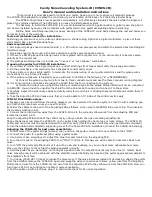
38
Controls & Functions
you would either have D major Pentatonic or B
minor Pentatonic (or even altered extensions).
Explore the music theory concepts of modes
and relative major/relative minor to deepen
your understanding of this concept.
NOTE:
The four scales given are the default set-
tings; users can also use the Claravox Centen-
nial software to assign other custom scales to
the four scale slots. This assignment is saved
per preset.
Main Output
Refer to Figure 17
Normally, this switch will be in the
ACTIVE
position, and Claravox Centennial will provide
an audio signal via three separate outputs:
the
AUDIO OUT
jack,
TUNER OUT
jack,
and (
HEADPHONE OUT
) jack. Setting this
MAIN OUTPUT
switch to the
MUTE
po-
sition will silence the
MAIN OUT
jack. The
(
HEADPHONE OUT
) jack and
TUNER
OUT
jack remain unaffected. In this way, the
output to the amplifier or sound system can be
interrupted, while the
(
HEADPHONE OUT
)
jack and
TUNER OUT
jack remain available
for tweaking the sound, checking the tuning, se-
lecting a new root note (key) or scale, etc.
TIP:
There is a
MUTE LED
indicator in the upper
right area of the front panel (just below the
MIDI
LED
indicator) that will remain lit while the
MAIN OUTPUT
switch is in the
MUTE
position.
If using an optional footswitch to control the Mute
setting, the
MUTE LED
will reflect the true Mute
status and may not always match the position of
the front panel
MUTE
switch.
Performance (Mode Switch)
Refer to Figure 18
Claravox Centennial delivers the best of both
worlds, as defined by the setting of the
PER-
FORMANCE
switch. For the theremin purist,
setting this
PERFORMANCE
switch to the
TRADITIONAL
position allows Claravox
Centennial to operate in the
TRADITION-
AL
mode. For the advanced artist, setting the
PERFORMANCE
switch to the
MODERN
position places Claravox Centennial in the
MODERN
mode and unlocks a host of en-
hanced theremin features.
Modern (Modern Mode)
The
MODERN
mode is powered by an ad-
vanced digital sound engine driven by two du-
al-mode oscillators (OSC 1 and OSC 2). OSC 1
and OSC 2 offer essential oscillator waveforms
and wavetable generated selections. OSC 1
follows the same signal path as the sole analog
oscillator in the
TRADITIONAL
mode. OSC
2 (along with a variable noise component) pass-
es through a single-pole multimode (Low Pass,
Band Pass, High Pass, Notch) filter and rejoins
OSC 1 before passing through the VCA and
then the Delay. Only the
MODERN
mode pro-
vides the enhanced Pitch parameters (Register,
Quantize, Root Note, and Scale) and the opti-
mized antenna response parameters (Volume
Содержание Claravox Centennial
Страница 1: ......
Страница 2: ...CELE BRATI N G YE ARS OF T HE T HEREMIN...
Страница 3: ......
Страница 8: ...Clara Rockmore PR photo with theremin New York 1932...
Страница 12: ...Clara Rockmore Recital Poster 1938...
Страница 20: ...19...
Страница 24: ...23...
Страница 25: ...Claravox Centennial Moog Music Inc...
Страница 28: ...Figure 7...
Страница 29: ...28 Figure 9 Figure 8 Learning How to Play...
Страница 33: ...Figure 13...
Страница 46: ...45 Figure 28 Figure 29 Controls Functions Figure 26 Figure 27...
Страница 48: ......
Страница 67: ...Clara Rockmore PR photo playing theremin New York mid to late 1930s...
Страница 70: ...69 69...
Страница 71: ...70 70...
Страница 76: ......
Страница 77: ......
















































